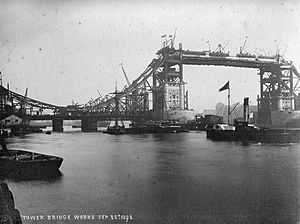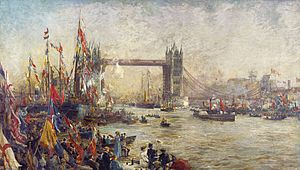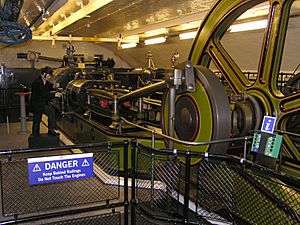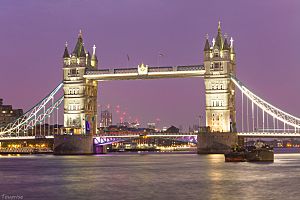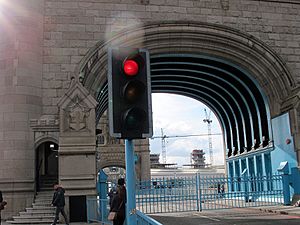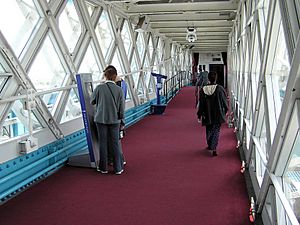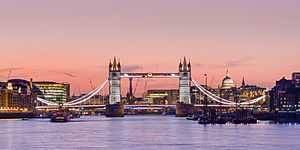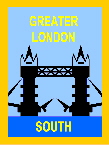Tower Bridge facts for kids
Quick facts for kids Tower Bridge |
|
|---|---|
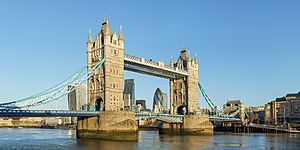
View from Shad Thames
|
|
| Carries | London Inner Ring Road |
| Crosses | River Thames |
| Locale | London boroughs: – north side: Tower Hamlets – south side: Southwark |
| Named for | Tower of London |
| Maintained by | City Bridge Foundation |
| Heritage status | Grade I listed building |
| Website | [www.towerbridge.org.uk] |
| Preceded by | London Bridge |
| Followed by | Elizabeth II Bridge |
| Characteristics | |
| Design | Bascule bridge / Suspension Bridge |
| Total length | 800 feet (240 m) |
| Height | 213 feet (65 m) |
| History | |
| Architect | Horace Jones |
| Construction begin | 21 June 1886 |
| Construction end | 1894 |
Tower Bridge is a Grade I listed combined bascule and suspension bridge in London, built between 1886 and 1894, designed by Horace Jones and engineered by John Wolfe Barry with the help of Henry Marc Brunel. It crosses the River Thames close to the Tower of London and is one of five London bridges owned and maintained by the City Bridge Foundation, a charitable trust founded in 1282. The bridge was constructed to give better access to the East End of London, which had expanded its commercial potential in the 19th century. The bridge was opened by Edward, Prince of Wales and Alexandra, Princess of Wales in 1894.
The bridge is 800 feet (240 m) in length and consists of two 213-foot (65 m) bridge towers connected at the upper level by two horizontal walkways, and a central pair of bascules that can open to allow shipping. Originally hydraulically powered, the operating mechanism was converted to an electro-hydraulic system in 1972. The bridge is part of the London Inner Ring Road and thus the boundary of the London congestion charge zone, and remains an important traffic route with 40,000 crossings every day. The bridge deck is freely accessible to both vehicles and pedestrians, whereas the bridge's twin towers, high-level walkways, and Victorian engine rooms form part of the Tower Bridge Exhibition.
Tower Bridge has become a recognisable London landmark. It is sometimes confused with London Bridge, about 0.5 miles (800 m) upstream, which has led to a persistent urban legend about an American purchasing the wrong bridge.
Contents
History
Inception
In the late 19th century, commercial development in the East End of London increased, leading to demand for a new river crossing downstream of London Bridge. A traditional fixed bridge at street level could not be built because it would cut off access by sailing ships to the port facilities in the Pool of London between London Bridge and the Tower of London.
A Special Bridge or Subway Committee chaired by Sir Albert Joseph Altman was formed in 1877 to find a solution. More than fifty designs were submitted, including one from civil engineer Sir Joseph Bazalgette, which was rejected because of a lack of sufficient headroom. A design was not approved until 1884 when it was decided to build a bascule bridge. Sir John Wolfe Barry was appointed engineer and Sir Horace Jones the architect (who was also one of the judges). An Act of Parliament authorising construction was passed in 1885. It specified that the opening span would provide a clear width of 200 feet (61 m) and headroom of 135 feet (41 m). The design had to be in a Gothic style. Construction was funded by the City Bridge Foundation, a charity established in 1282 for maintenance of London Bridge that subsequently expanded to cover Tower Bridge, Blackfriars Bridge, Southwark Bridge and the Millennium Bridge.
Barry designed a bridge with two bridge towers built on piers. The central span was split into two equal bascules or leaves, which could be raised to allow river traffic to pass. The two side spans were suspension bridges, with rods anchored both at the abutments and through rods contained in the bridge's upper walkways.
Construction
Construction started in 1886, with the foundation stone laid by the Prince of Wales on 21 June, and took eight years. Major contractors included Sir John Jackson (foundations), Armstrong, Mitchell and Company (hydraulics), William Webster, and Sir William Arrol & Co. 432 people worked on the site; E W Crutwell was the resident engineer for the construction.
Two piers, containing over 70,000 long tons (78,400 short tons; 71,123 t) of concrete, were sunk into the riverbed to support the construction. More than 11,000 long tons (12,320 short tons; 11,177 t) of steel were used in the framework for the towers and walkways, which were then clad in Cornish granite and Portland stone to protect the underlying steelwork.
Jones died in 1887, and George D. Stevenson took over the project. Stevenson replaced Jones's original brick façade with the more ornate Victorian Gothic style, which made the bridge a distinctive landmark and was intended to harmonise the bridge with the nearby Tower of London. The total cost of construction was £1,184,000 (equivalent to £96.6 million in 2021).
Opening
Tower Bridge was officially opened on 30 June 1894 by the Prince and Princess of Wales. The opening ceremony was attended by the Lord Chamberlain, the Lord Carrington and the Home Secretary, H. H. Asquith. An Act of Parliament stipulated that a tug boat should be on station to assist vessels in danger when crossing the bridge, a requirement that remained in place until the 1960s.
The bridge connected Iron Gate, on the north bank of the river, with Horselydown Lane, on the south – now known as Tower Bridge Approach and Tower Bridge Road, respectively. Until the bridge was opened, the Tower Subway – 400 m (0.25 mi) to the west – was the shortest way to cross the river from Tower Hill to Tooley Street in Southwark. Opened in 1870, Tower Subway was among the world's earliest underground ("tube") railways, but it closed after just three months and was reopened as a tolled pedestrian foot tunnel. Once Tower Bridge was open, the majority of foot traffic transferred to using the bridge, as there was no toll to cross. Having lost most of its income, the tunnel was closed in 1898.
The high-level open-air walkways between the towers gained a reputation for pickpockets. Since they were only accessible by stairs, the walkways were seldom used by regular pedestrians and were closed in 1910. The walkway reopened in 1982 as part of the Tower Bridge Exhibition.
20th century

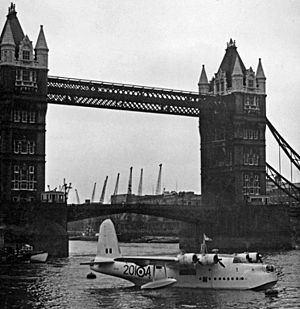
During the Second World War, Tower Bridge was seen as a major transport link to the Port of London, and consequently was a target for enemy action. In 1940, the high-level span took a direct hit, severing the hydraulic mechanism and taking the bridge out of action. In April 1941, a parachute mine exploded close to the bridge, causing serious damage to the bascule, towers, and engine room. In 1942, a third engine was installed in case the existing ones were damaged by enemy action. It was a 150 hp horizontal cross-compound engine, built by Vickers Armstrong Ltd. at their Elswick works in Newcastle upon Tyne. It was fitted with a flywheel having a 9-foot (2.7 m) diameter and weighing 9 tons, and was governed to a speed of 30 rpm. The engine became redundant when the rest of the system was modernised in 1974 and was donated to the Forncett Industrial Steam Museum by the City of London Corporation.
The southern section of the bridge, in the London Borough of Southwark, was Grade I listed on 6 December 1949. The remainder of the bridge, in the London Borough of Tower Hamlets, was listed on 27 September 1973. In 1974, the original operating mechanism was largely replaced by a new electro-hydraulic drive system, designed by BHA Cromwell House, with the original final pinions driven by modern hydraulic motors.
In 1982, the Tower Bridge Exhibition opened, housed in the bridge's twin towers, the long-closed high-level walkways, and the Victorian engine rooms. The latter still houses the original steam engines and some of the original hydraulic machinery.
21st century
The bridge closed for a month in 2000 to repair the bascules and perform other maintenance. A computer system was installed to control the raising and lowering of the bascules remotely. However, the system proved unreliable, resulting in the bridge being stuck in the open or closed positions on several occasions during 2005 until its sensors were replaced.
In April 2008, authorities announced that the bridge would undergo a £4 million refurbishment that would take four years to complete. The work entailed stripping existing paint down to bare metal and repainting in blue and white. Before this, the bridge's colour scheme dated from 1977, when it was painted red, white, and blue for Queen Elizabeth II's Silver Jubilee. Its colours were subsequently restored to blue and white. Each section was enshrouded in scaffolding and plastic sheeting to prevent the old paint falling into the Thames and causing pollution. Starting in mid-2008, contractors worked on a quarter of the bridge at a time to minimise disruption, but some road closures were inevitable. The completed work should stand for 25 years. The renovation of the walkway interior was completed in mid-2009. The renovation of the four suspension chains was completed in March 2010 using a state-of-the-art coating system requiring up to six different layers of paint. A lighting system based on RGB LED luminaires was installed, concealed within the bridge superstructure, and attached without drilling holes, owing to the bridge's Grade I listing.
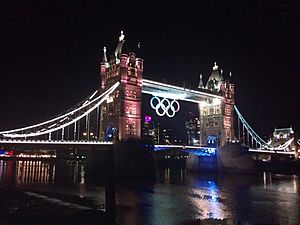
On 8 July 2012, as part of the London Olympics, the west walkway was transformed into a 200-foot-long (61 m) Live Music Sculpture by the British composer Samuel Bordoli. 30 classical musicians were arranged along the length of the bridge 138 feet (42 m) above the Thames behind the Olympic rings. The sound travelled backward and forwards along the walkway, echoing the structure of the bridge.
Following the Olympics, the rings were removed from Tower Bridge and replaced by the emblem of the Paralympic Games for the 2012 Summer Paralympics.
In 2016, Tower Bridge was closed to all road traffic from 1 October to 30 December. This was to allow structural maintenance work to take place on the timber decking, lifting mechanism and waterproofing the brick arches on the bridge's approaches. During this, the bridge was still open to waterborne traffic. It was open to pedestrians for all but three weekends when a free ferry service was in operation.
Design
Structure
The bridge is 800 feet (240 m) in length with two towers each 213 feet (65 m) high, built on piers. The central span of 200 feet (61 m) between the towers is split into two equal bascules, or leaves, which can be raised to an angle of 86 degrees to allow river traffic to pass. The bascules, weighing over 1,000 tons each, are counterbalanced to minimise the force required and allow raising in five minutes.
The two side spans are suspension bridges, each 270 feet (82 m) long, with the suspension rods anchored both at the abutments and through rods contained within the bridge's upper walkways. The pedestrian walkways are 143 feet (44 m) above the river at high tide and accessed by lifts and staircases.
There is a chimney on the bridge that is painted to look like a lamppost. It was connected to a fireplace in a guardroom located in one of the bridge piers.
Hydraulic system
The original raising mechanism was powered by pressurised water stored in several hydraulic accumulators. The system was designed and installed by Hamilton Owen Rendel while working for Armstrong, Mitchell and Company of Newcastle upon Tyne. Water at a pressure of 750 psi (5.2 MPa) was pumped into the accumulators by a pair of stationary steam engines. Each drove a force pump from its piston tail rod. The accumulators each comprise a 20-inch (51 cm) ram which sits a very heavy weight to maintain the desired pressure.
The entire hydraulic system along with the gas lighting system was installed by William Sugg & Co Ltd. The gas lighting was initially by open-flame burners within the lanterns, but was soon updated to the later incandescent system.
In 1974, the original operating mechanism was largely replaced by a new electro-hydraulic drive system, designed by BHA Cromwell House. The only remaining parts of the old system are the final pinions, which fit into the racks on the bascules and were driven by hydraulic motors and gearing. Oil is now used in place of water as the new hydraulic fluid.
Signalling and control
Originally, river traffic passing beneath the bridge was required to follow several rules and signals. Daytime control was provided by red semaphore signals, mounted on small control cabins on either end of both of the bridge piers. At night, coloured lights were used, in either direction, on both of the piers: two red lights to show that the bridge was closed, and two green to show that it was open. In foggy weather, a gong was sounded as well.
Vessels passing through the bridge were required to display signals. By day, a black ball at least 2 feet (0.61 m) in diameter was mounted high up where it could be seen. Night passage called for two red lights in the same position. Foggy weather required repeated blasts from the ship's steam whistle. If a black ball was suspended from the middle of each walkway (or a red light at night) this indicated that the bridge could not be opened. These signals were repeated about 1,000 yards (910 m) downstream, at Cherry Garden Pier, where boats needing to pass through the bridge had to hoist their signals/lights and sound their horn, as appropriate, to alert the Bridge Master.
Some of the control mechanism for the signalling equipment has been preserved and is housed in the Tower Bridge's museum.
Traffic
Road
Tower Bridge is still a busy crossing of the Thames, used by more than 40,000 people (motorists, cyclists, and pedestrians) every day. The bridge is on the London Inner Ring Road, and is on the eastern boundary of the London congestion charge zone (drivers do not incur the charge by crossing the bridge).
To maintain the integrity of the structure, the City of London Corporation has imposed a 20-mile-per-hour (32 km/h) speed restriction, and an 18-tonne (20-short-ton) weight limit on vehicles using the bridge. A camera system measures the speed of traffic crossing the bridge, using a number plate recognition system to send fixed penalty charges to speeding drivers.
A second system monitors other vehicle parameters. Induction loops and piezoelectric sensors are used to measure the weight, the height of the chassis above ground level, and the number of axles of each vehicle, with drivers of overweight vehicles also receiving fixed penalty notices.
Pedestrian
Pedestrians can walk across on the bascule bridge when it is down for auto and truck traffic. Ship traffic has priority, meaning traffic using the bascule bridge waits when the bridge opens for ships.
From the outset in 1894, the high-level connection was a pedestrian route and was intended to allow pedestrian movement to continue while the bascule bridge was open for ship traffic. The pedestrian walkways in each direction were changed to have glass floors in 2014. Lifts bring pedestrians up to and down from the high level pedestrian bridge. The upper walkways are part of the Tower Bridge Exhibition, which included a tour of the how the bascule bridge works. Pedestrians can view the city from the bridge and through its upper walkway. There is a fee for the Tower Bridge Exhibition, tickets are needed.
River
The bascules are raised about a thousand times a year. River traffic is now much reduced, but it still takes priority over road traffic. Today, 24 hours' notice is required before opening the bridge, and opening times are published in advance on the bridge's website; there is no charge for vessels to open the bridge.
Nearest Rail Stations
The nearest London Underground tube stations to Tower Bridge are Tower Hill on the Circle and District lines, London Bridge on the Jubilee and Northern lines and Bermondsey on the Jubilee line, and the nearest Docklands Light Railway station is Tower Gateway. The nearest National Rail stations are at Fenchurch Street and London Bridge.
Cycling
Transport for London have proposed Cycle Superhighway 4 to run across Tower Bridge.
Touring the bridge
The Tower Bridge attraction is a display housed inside the Bridge's Towers, the high-level Walkways, and the Victorian Engine Rooms. It uses films, photos, and interactive displays to explain why and how Tower Bridge was built. Visitors can access the original steam engines that once powered the bridge bascules, housed in Engine Rooms, underneath the south end of the bridge.
The attraction charges an admission fee. The entrance is from the Ticket Office on the west side of the North Tower, from where visitors can climb the stairs (or take a lift) to the high-level Walkways to cross to the South Tower. In the Towers and Walkways is interpretation about the history of the Bridge. The Walkways also provide views over the city, the Tower of London and the Pool of London, and include two Glass Floors, where you can look down to see the road and River Thames below. From the South Tower, visitors can visit exit and follow the Blue Line to the Victorian Engine Rooms, with the original steam engines, which are situated in a separate building underneath the southern approach to the Bridge.
Historic places adjacent to Tower Bridge
See also
 In Spanish: Puente de la Torre para niños
In Spanish: Puente de la Torre para niños
- List of bridges in London
- Crossings of the River Thames
- Moveable bridges
- Pool of London



